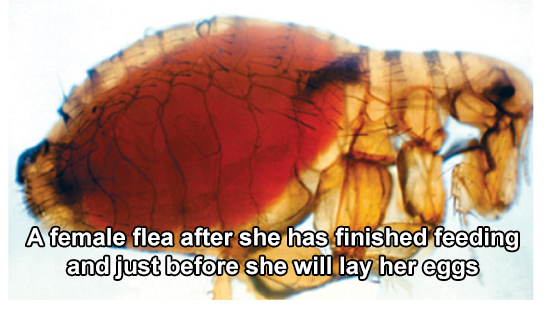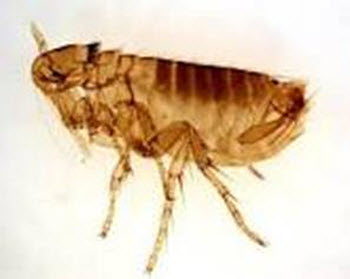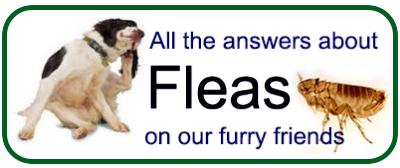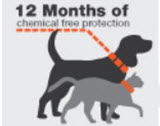Flea Types
Cat Fleas |
Chicken Fleas |
Dog Fleas |
Human Fleas
Northern Rat Flea |
Oriental Rat Flea

As long as mankind and animals have been around and probably well before that, fleas have existed. There are literally thousands of different types.
Experts use various criteria to identify different species; some of these are size, colour, habitat, population and even the position of spines on the head and body of adult fleas.
Here is a list of the most common types seen around domestic animals and inside and outside of our homes.
Cat Fleas
Cat fleas (Ctenocephalides Felis), are one of the most widespread and abundant species of flea on Earth. As the name implies, cat fleas live on cats, but they also live just as well on dogs, and numerous other domestic and wild animals. They are the most common fleas found on our pets.
Chicken Fleas
Chicken fleas as their name suggests, are a pest common to chickens. They live and breed anywhere people keep chickens and they are also found in the nests of wild birds. It is not uncommon for chicken fleas to jump on to and bite people who come in contact with chickens or birds infested with chicken fleas.
It is worthy of mention, that flea chickens are a constant menace to people in the poultry business and can cause havoc and untold damage if not kept in check.
The 3 main types of chicken fleas are
- Sticktight fleas (Echidnophaga gallinacean),are distinctive among poultry fleas in that the adults aren't mobile and prefer to remain attached to the skin of the birds' heads for days or even weeks. The females effectively eject their eggs so that they can make contact with surrounding litter to continue their cycle.
- Western hen fleas (Ceratophyllus niger), these fleas actually breed in the droppings of birds and rarely use birds or people as their hosts. In times gone by, bird droppings (guano) were highly prized as fertiliser. Man in his ignorance formed part of the chain of spreading the European chick fleas by shipping guano far and wide.
- European chick fleas (Gallinae), as the name implies, these fleas like to live on a certain group of birds which includes common domestic fowls/chickens, quails, pheasants and grouse,
Dog Fleas
Dog fleas (Ctenocephalides canis) are a type of flea which survives by sucking the blood blood of dogs, cats, foxes, coyotes and other animals including humans.
Its is a nasty flea and is extremely troublesome to its host. When an animal/human eat a dog flea infested with tape worm (Dipylidium Caninum) embryos, the life cycle of the tapeworm has effectively completed. The emryos develop into adult tapeworms which burrow into the linning of the host's stomach, and start to lay eggs and the cycle starts all over again.
The pet's bed is usually the most common place where tapeworm eggs are found. This will include your bed if your pet sleeps with you!! In actual fact tapeworm eggs will be found anywhere in and around your home that your pet frequents and sleeps.
Dogs and cats can also acquire tapeworms by eating rodents or lizards with infected fleas.
Human Fleas

If you have ever been bitten by a flea, you may have wondered whether fleas can live on people. The good news is, most fleas don't live on people, with one exception and that is the human flea (Pulex Irritans). Fortunately, human fleas prefer pigs and other wild life, and are rarely found in normal domestic homes. They are more often associated with homes near wildlife parks/animal sanctuaries/zoos and similar, especially in warm regions.
Northern Rat Flea
The northern rat flea (Nosopsyllus fasciatus) is a type of flea that is found on rats and mice in domestic homes. They can also be found on other external rodents, e.g. opossums, stokes, and ferrets. The flea originated in Europe but over time has been transported to temperate regions all over the world. They are found mostly on rodents, however they are not fussy and if brought into a domestic situation they will bite and suck human blood. This is apparent in highly populated areas.

Oriental Rat Flea
The Oriental Rat Flea (Xenopsylla cheopis) also known as the tropical rat flea, is a parasite of rodents; however it is equally comfortable biting and sucking blood from humans if the opportunity presents itself. In fact it is the flea most likely to be responsible for the transmission of the "bubonic plague", sometimes referred to as the "black death".
It is most often found on rats and rodents and is uniquely differentiated from cat flea and other fleas by the fact that it has no genal or pronotal combs
This article and information forms part of the Carole's Doggie World Holistic Library and is presented for informational purposes only.The information is not intended to be a substitute for visits to your local vet. Instead, the content offers the reader information researched and written by Carole Curtis for www.carolesdoggieworld.com






